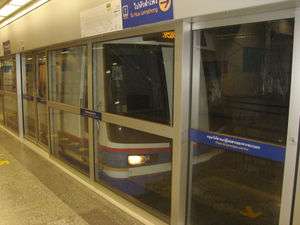MRT (Bangkok)
_logo.svg.png) | |
|
Blue Line, the first line of the MRT system | |
| Overview | |
|---|---|
| Native name | รถไฟฟ้ามหานคร |
| Owner | Mass Rapid Transit Authority of Thailand |
| Locale | Bangkok Metropolitan Region |
| Transit type |
Heavy rail (and monorail (planned)) |
| Number of lines |
2 in operation (1 planned) |
| Number of stations | 35[1] |
| Daily ridership | 253,255 (in 2014)[2] |
| Annual ridership | 92.4 million (in 2014)[2] |
| Operation | |
| Began operation | 3 July 2004 |
| Operator(s) | Bangkok Expressway and Metro Public Company Limited (SET: BEM) |
| Number of vehicles |
19 three-car trains Siemens Modular Metro (Blue Line) 21 three-car trains J-TREC (Purple Line) |
| Technical | |
| System length | 43 km (27 mi)[1] |
| Track gauge | 1,435 mm (4 ft 8 1⁄2 in) standard gauge |
| Electrification | Third rail |
| Top speed | 80 km/h (50 mph) |
The Metropolitan Rapid Transit or MRT is a rapid transit system serving the Bangkok Metropolitan Region in Thailand. The first section of the Blue Line between Hua Lamphong and Bang Sue opened in 2004 as Bangkok's second public transit system, while the MRT Purple Line opened in August 2016. The MRT is operated by the Bangkok Expressway and Metro Public Company Limited (BEM) under a concession granted by the Mass Rapid Transit Authority of Thailand (MRTA). Along with the Bangkok Mass Transit System (BTS, also called the Skytrain), and the Airport Rail Link (ARL), the MRT is part of Bangkok's rail transportation infrastructure.
The MRT serves more than 240,000 passengers each day. It has 35 operational stations along 43 kilometers (27 mi)[1] of underground route. The Blue Line, officially the Chaloem Ratchamongkhon Line, was the first of the two lines currently in operation. As of 2016, two extensions of the Blue Line are under construction. When completed, the Blue Line will become a loop line around the centre of Bangkok, with an extension to Bang Khae on its western side. The MRT Purple Line, officially the Chalong Ratchadham Line, began its full service on August 6, 2016. MRT Purple Line will connect Bang Sue with Nonthaburi in the north-west, and will be the first public transit line outside the Bangkok Metropolitan Administration.
The MRT line is officially known in Thai as rotfaifa mahanakhon (รถไฟฟ้ามหานคร) or "metropolitan electric train", but it is more commonly called rotfai taidin (รถไฟใต้ดิน), literally, "underground train".
History
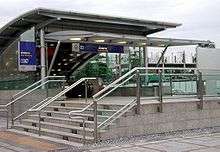


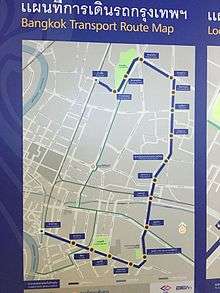
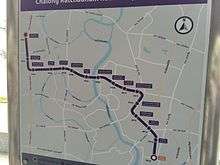
The MRT was constructed under a concession concept. For the first MRT line, officially known as Chaloem Ratchamongkhon or informally as the "Blue Line", most civil infrastructure were provided by the government sector, Mass Rapid Transit Authority of Thailand (MRTA), and handed over to their concessionaire under a 25-year concession agreement. Bangkok Expressway and Metro Public Company Limited (BEM) was the only private sector company that won a bid in MRTA's concession contract for the blue line. As MRTA's concessionaire, BEM provides M&E equipment, including electrical trains, signalling systems, SCADA, communication, PSD, etc. for the subway project and fully operates the system. To maintain the system, BEM has subcontracted in 10 years to Siemens which was the M&E system supplier since system opening and 7 years maintenance contract to two local maintenance services for north and south line.
The construction of the first Bangkok Metro line, officially known as Chaloem Ratchamongkhon (Thai สายเฉลิมรัชมงคล) – "Celebration of Royal Auspice" – or informally as the "Blue Line", began on 19 November 1996. The project suffered multiple delays not only because of the 1997 economic crisis, but also due to challenging civil engineering works of constructing massive underground structures deep in the water-logged soil upon which the city is built.
The Blue Line was opened for a limited public trial period of several weeks starting on 13 April 2004. On 3 July 2004 the line was officially opened at 19:19 local time by HM King Bhumibol and Queen Sirikit, who were accompanied by other members of the royal family. Within 30 minutes of its opening, sightseers filled the system to its maximum capacity, but after the initial rush ridership has settled down to around 180,000 riders daily — considerably lower than projections of over 400,000, despite fares being slashed in half from 12-38 baht to 10-15 baht per trip. From 2006 until 2008, fares ranged between 14-36 baht per trip. The fare was raised to 16-41 Baht on 1 January 2009. Current daily ridership (2014) stands at about 253,000.[2]
In August 2016, The Purple Line was opened.
Operation
The 20-kilometre, 18-station Blue line[1] presently runs from Bang Sue to Hua Lamphong via Phra Ram 9 and has a carrying capacity of 40,000 people in each direction per hour. Similar to the Skytrain, the Metro uses trains supplied by Siemens which travel up to 80 km/h. Passengers can conveniently connect to the Skytrain at Si Lom, Sukhumvit and Chatuchak Park stations. The metro has a large depot in Huai Khwang district, which is located between Phra Ram 9 and Thailand Cultural Centre stations.
Considering that Bangkok is a low-lying plain which is prone to flooding, all of the Metro's station entrances are raised about one metre above the ground level and are equipped with built-in floodgates in order to avoid water inundating the system. Lifts and ramps are found at all stations, providing easy access for passengers in wheelchairs. Stations have multiple passageways (generally four) which allow passengers to connect to any corner of the adjacent surface intersection. Passageways between exits are very spacious and some are beginning to open as malls. Maps depicting the local area and exit points are posted on the walls on the way out.
Due to safety considerations, platform screen doors are installed. Uniformed security personnel and security cameras are present at all platforms. Currently 19 three-car metro trains, of the Siemens Modular Metro type, are used. Each metro train consists of two motor cars and a centre trailer car.[3]
Ticketing

The ticketing system uses RFID contactless technology with round tokens issued for single trips and a contactless stored value card, the MRT Plus card, for frequent travellers. It is planned that a joint ticketing system will be set up[4] so that passengers can use a single ticket on the MRT as well as on the Skytrain. Multi-storey park & ride facilities are provided at Lat Phrao and Thailand Cultural Centre. Motorists who park their cars at these premises will be issued with additional contactless smartcards and they need to have them electronically stamped at their destination station. The turnstiles accept cards or tokens, both available from a manned booth or automated ticket machines.
Smart cards are available in two types:
- A rechargeable card for distance-based fares:
- for adults, at the same rate as single fares
- for students, not over 23 years old, at 10% discount
- for children/elderly, not over 14 old and height between 91–120 cm, or not less than 60 old, each with 50% discount.
- An unlimited travel card for fixed amount of 1, 3 and 30 days, costing 120, 230, and 1,400 Baht respectively.
Children whose age is not over 14 or whose height does not exceed 90 cm enjoy free rides. Reduced fares for children and elderly also apply when buying a token at the booth.
Lines
The first line opened is the Blue Line, on 3 July 2004. It runs eastward from Bang Sue Station in Chatuchak District along Kamphaeng Phet, Phahon Yothin and Lat Phrao Roads, then turns south following Ratchadaphisek Road, then west following Rama IV Road to Hua Lamphong Station in Pathum Wan District. The second line, Purple Line opened in 2016.
| Line | Stations | Length [km] | Length [mi] | Terminus | Daily ridership | Began operation | |
|---|---|---|---|---|---|---|---|
| Initial part | Last extension | ||||||
| MRT Blue Line | 19[5][6] | 20 | 12[7] | Hua Lamphong ↔ Tao Poon[8][9] | 240,000 | 2004 | 2017[10][11] |
| MRT Purple Line | 16 | 23 | 14 | Khlong Bang Phai ↔ Tao Poon | 20,000[12] | 2016 | - |
| Total | 43 | 27 | |||||
Blue Line
The first line, 20-kilometer, 18-station Blue line[1] presently runs from Bang Sue to Hua Lamphong via Phra Ram 9 and has a carrying capacity of 40,000 people in each direction per hour. Similar to the Skytrain, the Metro uses trains supplied by Siemens which travel up to 80 km/h. Passengers can conveniently connect to the Skytrain at Si Lom, Sukhumvit and Chatuchak Park stations. The metro has a large depot in Huai Khwang district, which is located between Phra Ram 9 and Thailand Cultural Centre stations.
Purple Line
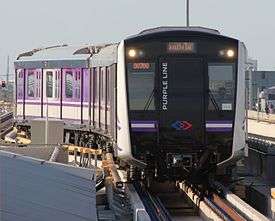
The Purple Line is aimed to serve travel demand between the northwestern suburb of Bangkok in Nonthaburi Province and southern area of Thonburi in Phra Pradaeng District, Samut Prakan Province. It also runs through downtown along Samsen Road, passing Rattanakosin old quarter and many historical places in Dusit and Phra Nakhon District like the national library, Thewet market, Bang Lamphu, the Democracy Monument, the Golden Mount, Phahurat, the Memorial Bridge and Wongwian Yai roundabout, and also intends to serve the new Thai parliament construction site at Kiak Kai intersection.
This Line is divided into two sections, Tao Poon - Khlong Bang Phai 23 km, which is opened in 2016, and a planned section from Tao Poon - Phra Pradaeng, 19.8 km.
Expansion plans
| Line | Proposed opening | Terminal | Length [km] | Length [mile] | Stations | Status | |
|---|---|---|---|---|---|---|---|
| extension (Heavy rail) |
2019 | Bang Sue | Tha Phra | 13 | 8.1 | 7 | Under construction |
| 2019 | Hua Lamphong | Lak Song | 14 | 8.7 | 10 | Under construction | |
| 2021 | Lak Song | Phutthamonthon Sai 4 | 8 | 5.0 | 5 | Planned | |
| extension (Heavy rail) |
2022 | Tao Poon | Phra Pradaeng | 20 | 12 | 17 | Planned |
| (Heavy rail) | 2022 | Bang Khun Non | Suvinthawong | 37.5 | 23.3 | 29 | Approved |
| (Monorail) | 2021 | Nonthaburi Civic Center | Min Buri | 35 | 22 | 30 | Approved |
| (Monorail) | 2021 (Phase 1) | Lat Phrao | Samrong | 30.4 | 18.9 | 23 | Approved |
| (Monorail) | 2025(?) | Nonthaburi Civic Center | Sammakon | 22 | 14 | 23 | Planned |
Various expansion plans of the Metro have been proposed. It is planned that, eventually, the combined route distance of the Metro alone will total 91 km with 3 Metro lines covering all of the major areas of Bangkok. The Blue line, once completely extended, will form a lariat-shaped loop encircling the city.
As per the BMCL's annual report, earning of profit from operation is still far away and BMCL is still subsidized by main share holder which is CH Karnchang.
Blue Line extension
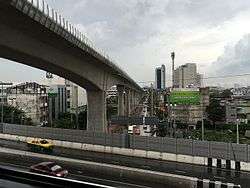
- Bang Sue – Bang Phlat – Tha Phra (under construction, operational in 2016). It starts from Bang Sue Station, passing along Pracharat Sai 2 Road. It crosses Chao Phraya River and turns left along Charansanitwong Road until it reaches Tha Phra at Petch Kasem and Charansanitwong intersection. The length is 13.1 km with 7 elevated stations.
- Hua Lamphong – Tha Phra – Lak Song (under construction, operational in 2016). From Hua Lamphong Station it goes along Charoen Krung Road, passes Wat Mangkon Kamalawat Station, Wang Burapha Station, and then turns left at Wat Pho before crossing under the Chao Phraya River at Pak Khlong Talart. Passing through Issaraphap, it finally enters Petch Kasem Road and ends at Lak Song. The 4 underground stations end at Tha Phra before turning to be elevated for 6 stations. The length is 13.9 km. with 8.9 km elevated station and 4.8 km underground stations.
- Lak Song – Phutthamonthon Sai 4 (planned operational in 2025).
Orange Line
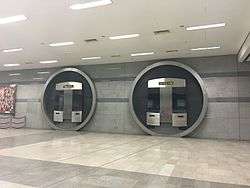
The Orange Line will start from Min Buri as elevated structure on Ramkhamhaeng Road (former Suka Phiban III Road) from eastern suburb in Min Buri District and goes underground near Lam Sali intersection in Bang Kapi District, also transfers to MRT Yellow Line. It continues southwest along Ramkhamhaeng Road, passing Hua Mak Stadium and Ramkhamhaeng University. Then it turns to the west and crosses Pradit Manutham Road to the current MRT depot. Then it goes to Thailand Cultural Centre Station, the alignment crosses over and transfers to the current MRT Blue Line. It continues via Din Daeng housing estates and Bangkok City Hall 2 to Vibhavadi Rangsit Road, Sam Liam Din Daeng Junction. Then turn left into Ratchaprarop Road towards Pratunam and turn right into Phetchaburi Road then interchange with BTS Sukhumvit Line at Ratchathewi Station. It continues along Larn Luang Road and Ratchadamnoen Road. Then crosses the Chao Phraya River near Phra Pinklao Bridge, passes Siriraj Hospital and goes along Bangkok Noi Rail line and terminates at Bang Khun Non Station, interchanges with MRT Blue Line again. The total length is 37.5 km.
This Line is divided into 3 sections
- Bang Khun Non - Thailand Cultural Centre (17.5-km)
- Thailand Cultural Centre - Bang Kapi (9-km)
- Bang Kapi - Min Buri (11-km).
The section from Bang Khun Non to Bang Kapi is scheduled to be completed in 2019/20. However, the planned tender date of late 2013 has been delayed by at least 15 months until 2015 due to political turmoil in late 2013 until May 2014.
When fully completed, the line will be 37.5-km long, mostly underground, with 29 stations (7 elevated stations and other 22 underground stations, including the current Thailand Cultural Centre Station of MRT Blue Line).
Pink Line
The 35.5 km long Pink line will have 30 stations and will be a monorail line. It will run in the northern part of the city from east Bangkok in Minburi District (also transfers to MRT Orange Line) along Ram Inthra Road to west Bangkok (Pak Kret district, Nonthaburi Province) Chaeng Watthana Road and Tiwanon Road ending at The Nonthaburi Civic Center which transfer to the MRT Purple Line.
The line will also transfer with the SRT Dark Red Line which is under construction, the planned BTS Sukhumvit Line extension to Lam Lukka, and the planned MRT Grey Line in the future.
The Pink line was due to be tendered in the 3rd quarter of 2013 with construction due to commence in early 2014.[13] However, delays in preparation of the tender in relation to the selection of monorail rolling stock and subsequent political protests resulting in a snap national election in early Feb 2014, further delayed the Pink Line tender.[14] A subsequent coup in May 2014 resulted in a new military administration and the tender being deferred for 2014. More likely, the tender will not be ready until mid 2015 according to the MRTA.
Yellow Line
The 30.4 km long Yellow line will have 20 stations. It was originally proposed to be an underground and elevated heavy rail line. However, it is now planned to be built as an elevated monorail line. The line will be built in two phases and with Phase 1 planned to be completed by 2019.
In Dec 2011, the MRTA was instructed by the MOT to divide the Yellow Line into two Phases for tender and construction purposes and to control land appropriation costs.[15] In June 2012, the MRTA contracted consultants to undertake detailed designs of the Yellow Line. In Feb 2013, OTP stated that the tender for the Yellow line should be ready by late 2013 for tender in early 2014[16] However, similar to the Pink Line, delays in finalising the technical requirements of the tender in relation to the selection of monorail rolling stock which determines the type of track to be constructed resulted in a significant delay. The subsequent political turmoil of 2014 caused further delay. Thereafter, the coup of May 2014 resulted in a new military administration and the tender being deferred for 2014. The Yellow Line tender will proceed after the Pink and Orange Lines have been tendered according to the MRTA.
Once the Yellow Line is complete, a future extension may eventually be built from Samrong across the Chao Praya River to link with the MRT Purple Line at Rat Burana.
Brown Line
The 20.5 km long Brown line is under study by the OTP. It is proposed to run from Khae Rai, Nonthaburi to Bueng Kum with 21 stations and be a monorail line.
The line was originally proposed as the Gold Line by the Pheu Thai party for the Bangkok Governors election held in March 2013. This was in response to objections by Kasetart University to long proposed Expressway extensions in the area. The line would essentially have replaced the need to build an elevated Expressway.[17] However, the Pheu Thai candidate did not win the Bangkok Governor election and the Gold Line was dropped with the Deputy Minister of Transport stating that land appropriation costs were too high.[18] Subsequently, OTP has reworked the Gold Line proposal into a new Brown Line following much the same route. As of June 2013 the route was under preliminary study by OTP.[19]
This line should not be confused with the original 2004 13 km MRT Brown Line proposal from Bang Kapi to Min Buri. This was subsequently merged in 2009 into an extended MRT Orange Line.
Major accident record
On 17 January 2005, just after 09:15, an empty train returning to the depot collided with a peak-hour train filled with passengers at the Thailand Cultural Centre MRT Station. 140 people were hurt, most of whom sustained only minor injuries and the entire Metro network was shut down for two weeks.
After initial investigations, it was found that the empty train had run into problems shortly before the accident, grinding to a halt on a curve leading to the depot. The driver applied the train brake and was waiting to be towed to the maintenance centre close to the Thailand Cultural Centre station.
A rescue train was attempting to connect to the stalled train when the driver was told to release the brake even though coupling had not been successful. It was then that the empty train began to roll backwards at a speed of ten metres per second and into the other train, which was carrying passengers. Therefore, it was believed that the incident was caused by negligence due to insufficient training of operation staff.[20] This accident caused damage to both trainsets, with heavily damaged areas limited to the two cars that collided. From the extent of the damage, investigators estimated the collision speed to be around 60 km/h. However, one train, which was rebuilt from the repair of the minor-damaged cars, was already fitted for operation at the end of 2006 and the remaining one was still under heavy repair until mid of 2007; it was released into service in October, 2007. The cost resulting from the accident might be a much higher figure than BMCL quoted, and it was expected to be at least 400 million baht, which was totally insured by a local insurance company.
The Metro resumed full operation on 1 February 2005, and passenger numbers soon rose back to pre-crash levels, partly due to a temporary promotional fare scheme which allowed passengers to travel any distance on the MRT for only ten baht (~0.33 USD).
See also
- BTS Skytrain
- Airport Rail Link (Bangkok)
- SRT Red Lines
- Bangkok BRT
- List of rapid transit systems
- List of rapid transit stations in Bangkok
References
- 1 2 3 4 5 "M.R.T. Chaloem Ratchamongkhon Line". Mass Rapid Transit Authority of Thailand (MRTA). Retrieved 2014-06-27.
- 1 2 3 "Bangkok Metro Public Corporation Annual Report 2014" (pdf). 2015. p. 6. Retrieved 2016-01-07.
- ↑ "Bangkok Metro, Thailand". Railway-Technology.com. Retrieved 2014-06-27.
- ↑ "Single ticket for city transport". Bangkok Post. Retrieved 2016-09-11.
- ↑ http://www.thairath.co.th/content/763412
- ↑ http://www.matichon.co.th/news/334306
- ↑ M.R.T. Chaloem Ratchamongkhon Line Mass Rapid Transit Authority of Thailand. 2014
- ↑ http://www.thairath.co.th/content/763412
- ↑ http://www.matichon.co.th/news/334306
- ↑ http://www.thairath.co.th/content/763412
- ↑ http://www.matichon.co.th/news/334306
- ↑ PCL., Post Publishing. "Purple Line: Newly launched, but few using it". Retrieved 2016-08-31.
- ↑ "Cabinet to mull rail projects" Bangkok Post, 26 Feb 2013
- ↑ "http://www.thaipost.net/news/121213/83272"
- ↑ แจ้งเกิดรถไฟฟ้า2สาย สุกำพลเครื่องร้อน. ThanOnline (in Thai). 27 December 2011. Retrieved 2014-06-27.
- ↑ สนข.เร่งสร้างรถไฟฟ้า ฟุ้งปี56ได้ใช้ตั๋วร่วมแน่. Thaipost (in Thai). 11 February 2013. Retrieved 2014-06-27.
- ↑ "Kasetsart backs light rail move". Bangkok Post. 12 February 2013. Retrieved 2014-06-27.
- ↑ "City expressway plan redrawn to go north". Bangkok Post. 14 May 2013. Retrieved 2014-06-27.
- ↑ https://www.facebook.com/kucityfanpage/posts/381668901937571
- ↑ "Thai subway shut for safety probe". BBC News. 17 January 2005. Retrieved 2010-05-13.
External links
| Wikimedia Commons has media related to Bangkok Metro. |
Official sites
- Mass Rapid Transit Authority of Thailand
- Bangkok MRT Master Plan - Office of Transport and Traffic Policy Planning
- Bangkok Metro Company Limited
